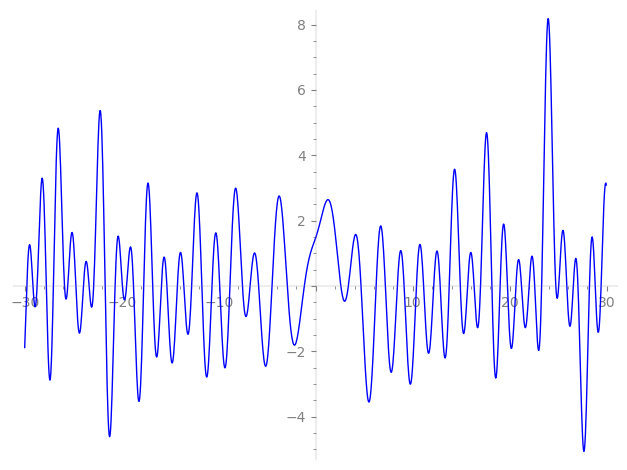| L(s) = 1 | + (0.173 + 0.300i)2-s + (0.5 − 0.866i)3-s + (0.939 − 1.62i)4-s + (−0.326 − 0.565i)5-s + 0.347·6-s + (−2.05 − 1.66i)7-s + 1.34·8-s + (−0.499 − 0.866i)9-s + (0.113 − 0.196i)10-s + (−0.266 + 0.460i)11-s + (−0.939 − 1.62i)12-s + 13-s + (0.145 − 0.907i)14-s − 0.652·15-s + (−1.64 − 2.84i)16-s + (−0.560 + 0.970i)17-s + ⋯ |
| L(s) = 1 | + (0.122 + 0.212i)2-s + (0.288 − 0.499i)3-s + (0.469 − 0.813i)4-s + (−0.145 − 0.252i)5-s + 0.141·6-s + (−0.775 − 0.630i)7-s + 0.476·8-s + (−0.166 − 0.288i)9-s + (0.0358 − 0.0620i)10-s + (−0.0802 + 0.138i)11-s + (−0.271 − 0.469i)12-s + 0.277·13-s + (0.0388 − 0.242i)14-s − 0.168·15-s + (−0.411 − 0.712i)16-s + (−0.135 + 0.235i)17-s + ⋯ |
\[\begin{aligned}\Lambda(s)=\mathstrut & 273 ^{s/2} \, \Gamma_{\C}(s) \, L(s)\cr =\mathstrut & (0.296 + 0.954i)\, \overline{\Lambda}(2-s) \end{aligned}\]
\[\begin{aligned}\Lambda(s)=\mathstrut & 273 ^{s/2} \, \Gamma_{\C}(s+1/2) \, L(s)\cr =\mathstrut & (0.296 + 0.954i)\, \overline{\Lambda}(1-s) \end{aligned}\]
Particular Values
| \(L(1)\) |
\(\approx\) |
\(1.19292 - 0.878500i\) |
| \(L(\frac12)\) |
\(\approx\) |
\(1.19292 - 0.878500i\) |
| \(L(\frac{3}{2})\) |
|
not available |
| \(L(1)\) |
|
not available |
\(L(s) = \displaystyle \prod_{p} F_p(p^{-s})^{-1} \)
| $p$ | $F_p(T)$ |
|---|
| bad | 3 | \( 1 + (-0.5 + 0.866i)T \) |
| 7 | \( 1 + (2.05 + 1.66i)T \) |
| 13 | \( 1 - T \) |
| good | 2 | \( 1 + (-0.173 - 0.300i)T + (-1 + 1.73i)T^{2} \) |
| 5 | \( 1 + (0.326 + 0.565i)T + (-2.5 + 4.33i)T^{2} \) |
| 11 | \( 1 + (0.266 - 0.460i)T + (-5.5 - 9.52i)T^{2} \) |
| 17 | \( 1 + (0.560 - 0.970i)T + (-8.5 - 14.7i)T^{2} \) |
| 19 | \( 1 + (0.152 + 0.264i)T + (-9.5 + 16.4i)T^{2} \) |
| 23 | \( 1 + (-4.00 - 6.93i)T + (-11.5 + 19.9i)T^{2} \) |
| 29 | \( 1 - 7.78T + 29T^{2} \) |
| 31 | \( 1 + (0.294 - 0.509i)T + (-15.5 - 26.8i)T^{2} \) |
| 37 | \( 1 + (-1.43 - 2.49i)T + (-18.5 + 32.0i)T^{2} \) |
| 41 | \( 1 + 1.04T + 41T^{2} \) |
| 43 | \( 1 - 2.94T + 43T^{2} \) |
| 47 | \( 1 + (-2.06 - 3.57i)T + (-23.5 + 40.7i)T^{2} \) |
| 53 | \( 1 + (-1.26 + 2.19i)T + (-26.5 - 45.8i)T^{2} \) |
| 59 | \( 1 + (7.19 - 12.4i)T + (-29.5 - 51.0i)T^{2} \) |
| 61 | \( 1 + (3.92 + 6.80i)T + (-30.5 + 52.8i)T^{2} \) |
| 67 | \( 1 + (2.33 - 4.03i)T + (-33.5 - 58.0i)T^{2} \) |
| 71 | \( 1 + 3.92T + 71T^{2} \) |
| 73 | \( 1 + (5.81 - 10.0i)T + (-36.5 - 63.2i)T^{2} \) |
| 79 | \( 1 + (1.46 + 2.53i)T + (-39.5 + 68.4i)T^{2} \) |
| 83 | \( 1 + 2.46T + 83T^{2} \) |
| 89 | \( 1 + (5.49 + 9.51i)T + (-44.5 + 77.0i)T^{2} \) |
| 97 | \( 1 - 10.2T + 97T^{2} \) |
| show more | |
| show less | |
\(L(s) = \displaystyle\prod_p \ \prod_{j=1}^{2} (1 - \alpha_{j,p}\, p^{-s})^{-1}\)
Imaginary part of the first few zeros on the critical line
−11.73670511068035167172931214343, −10.69516423836760826712654364642, −9.894374238523594599880735385857, −8.845398415030480255114966921359, −7.55632996601080875364379862019, −6.76545263227777183016467756879, −5.88513707041164825195723053751, −4.50563588954114942163101744582, −2.93351789920650251845436177056, −1.17507455901818428429550140513,
2.59059504175149591801815944807, 3.36326774071587102728682926231, 4.66976418244345027695388234427, 6.22492053912946405691276892648, 7.17810059438736441355742401884, 8.410155859078793777483769898026, 9.110376380575321231881207774483, 10.38009137394890463494845047214, 11.12039925095858321085011637829, 12.15920154037025580940819901160

